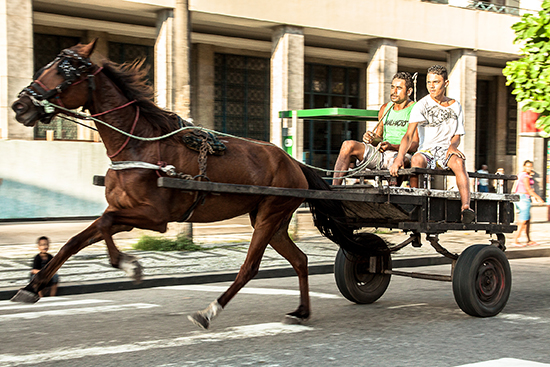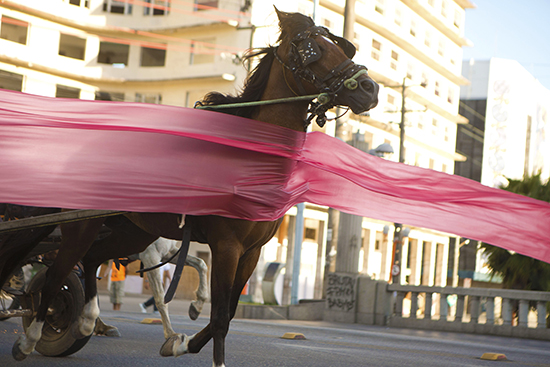April 30, 2015
Shooting a Movie/Cleaning a Tunnel: Jonathas de Andrade and Alexandre Orion’s interventions in Recife and São Paulo, Brazil
Written by Carolin Köchling
Jonathas de Andrade organized the first horse-drawn cart race in the center of Recife, a city in the Northeast of Brazil. Hundreds of cart drivers took to the streets, surrounded by the modernist buildings that define the city’s landscape. Horses are usually prohibited throughout the town - they exist, but only out of sight in the suburbs, which constitute a socially deprived parallel society excluded from the city’s economic and cultural orientation. De Andrade thus needed a permit for his project O Levante (The Uprising) from the municipal administration. In order to obtain it he announced his intention to produce a film and was ultimately given the right to realize the event.
Alexandre Orion’s intervention Ossário (Graveyard) took place in an underpass in São Paulo. Millions of cars pass through this tunnel in the center of the city every day. When Orion arrived the tunnel walls were entirely exhaust-blackened. He decided to wipe away the layer of soot to create a 300-meter-long series of skulls addressing the anonymous audience of car drivers. This technique made the city—or, more specifically, the manifestation of its air pollution—the sole material of the painting. Thus, production and reception took place simultaneously. What is more, the car drivers themselves contributed to the painting physically in that they produced its material merely by driving by. The police had tried to stop Orion many times, but he argued that all he was doing was cleaning the tunnel walls.
The interventions took place in 2012 and 2006. Jonathas de Andrade, born 1982 in Recife, is an artist clearly operating within the field of art. The work of Alexandre Orion, born in 1978 in São Paulo, in contrast emerges in the field of graffiti. Their projects demonstrate an approach that enters social contexts and provoke a reaction outside the field of art. They use either a medium - shooting a movie - or invent a technique – creating a painting by cleaning the tunnel walls - as a tool to attract the desired attention. By understanding the legal boundaries and possibilities of the system and making them productive, both works also manifest a meta-level that reflects the boundaries and possibilities of their respective medium.

As de Andrade’s film essentially served as a means of realizing the horse cart race, the film medium receives a new definition over and above its usual function: While it actually does document the event, it differs from a conventional documentary in that here the event would never have happened without the film. It is also distinct from a feature film, which stages a fiction. What we see in de Andrade’s film is not staged. The people are not acting; they do not even seem to be aware of being filmed. They are engaged in an activity entirely familiar to them - the race - and not in being part of an art project. That designation was merely the starting point, the legitimation of the event, since it was only the assertion of a fiction – a “fictitious fiction”, so to speak – that allowed their everyday reality to be transported to the prestigious boulevards of the city’s center. Later on view in institutional shows, the documentation of the project comes full circle back to the field of art, its starting point. The artist uses its liberties as an excuse to achieve the forbidden within the realm of society.

Orion, on the other hand, has often pointed out that the last thing he wants to do is art. This does not mean that he refuses to do art, rather that art is not his motivation. The city government eventually responded to Ossário by cleaning the wall in the area of the painting. This removal shifted the project to the level of discourse. Discussion now ensued about the criminal character of graffiti: the act of defacing a public surface however did not apply to Orion’s work. The cleaning was thus a form of substantive censorship. It further raised a dialogue conducted by different protagonists. As the rest of the tunnel remained covered with soot, Orion continued his production, thus prompting the government to remove it again and again, which ultimately led to its cleaning all of the tunnels in the entire neighborhood. The shift of focus away from the artist to the artwork ‒ or, more specifically, to the audience’s contribution to the production of his painting and its removal by the government ‒ is exceptional within the field of graffiti, where an individual style is required to set each author apart from the others in the cacophony of a city. Orion’s work, however, makes aesthetic categories obsolete. The artist relinquishes his control; the work constitutes itself in dependence on the actions and reactions of different participants. The filmic documentation of the project encompasses the entire process of the work’s execution and reception. Available on youtube, it reaches a huge audience far beyond that which participated in the dialogue prompted by it in the local society.
The videos of both projects ensure that the action that materialized within a certain limited time span will survive in the long-term. The substance of the two works, however, lies in the temporary situations in which they called attention to aspects of society that are hidden: the population of the suburbs - or tolerated: the air pollution. They thus explore ways of transforming the already existing into a hybrid consisting of both the social and political circumstances in which the artists intervene and the artistic tool that is needed to make the intervention happen.
In Brazil there is a strong tradition of public interventions that respond to and have an impact on the political circumstances. During the military dictatorship (1964–85), artists invested great efforts into trying to reach a broader public outside the institutional context of museums, which were censored by the regime. This was particularly true after the government introduced the Ato Institucional #5 at the end of 1968, a decree that sanctioned torture to protect the political system and imposed drastic censorship on the media and the arts. Artists of this generation developed new means of expression to address political and ethical questions. To conceal their authorship, they often used the public space as the venue for displaying their work. Claudia Calirman has recently discussed this period in her book: Brazilian Art under Dictatorship: Antonio Manuel, Artur Barrio, and Cildo Meireles (Durham: Duke University Press, 2012). Artur Barrio installed his cadaver-like sculptures in the city streets and parks; Cildo Meireles used the distribution of Coca Cola bottles and bank notes as the vehicle for text messages in his work Inserçoes em circuitos ideológicos (Insertions into Ideological Circuits). The “insertions” included injunctions on both banknotes and glass bottles such as “Down with the Dictatorship” as well as rhetorical questions such as “Who Killed Herzog?” This referred to a journalist who was accused of subversion and tortured to death in October 1975. The texts on the glass bottles were only visible once they had been refilled - thus only readable by the consumer. And, as Meireles pointed out, nobody would through away a bank note because he or she did not agree with the text message printed on it. These platforms were the only means of forcing a broad public to encounter his work.
Accordingly, the projects by de Andrade and Orion demonstrate an awareness of the flaws in the political and cultural system and make productive use of them. The conditions under which artists worked during the repressive years in Brazil, when they had to fear torture by the regime, defy comparison with artistic practices emerging today. Whereas the field of art was controlled and censored during that period, artists of a younger generation take advantage of the liberties it offers today. What is comparable, on the other hand, is that this younger generation of artists enters social contexts and provokes a reaction in the local society, an approach that finds its roots in Meireles’ groundbreaking circulation pieces. They choose settings and formats that define the boundaries between the permissible and the forbidden and confront their audiences with the meanings conveyed by their interventions. As inhabitants of Recife or car drivers in São Paulo, the audiences moreover have a strong relationship to the social circumstances the works are referring to and taking place in.
Carolin Köchling is an art historian and curator based in Berlin. As a curator at Schirn Kunsthalle Frankfurt she realized, among other projects, a show on Brazilian street-art in 2013. Since 2011 she has been teaching regularly in the Art History Department of the Goethe University Frankfurt.











